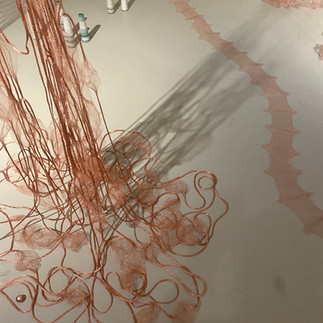Begriff des Körpers
- Daniela Brill Estrada
- Jul 8
- 3 min read
Updated: Aug 22
Begriff des Körpers is a collaborative project with Monica C.LoCascio, which resulted from years of conversations, friendship, and a shared curiosity about the unexplainable and ungraspable elements of the universe, as well as the materials we use to try to make sense of them. The first iteration of the project was made after our residency at the University of Nottingham with the ARTlab Nottingham, and it was exhibited at the Lakeside Gallery in "Cosmic Titans: Art, Science and the Quantum Universe" at the beginning of 2025. The second iteration of this work will be exhibited in London at the Science Gallery in "Quantum Untangled" opening on the 8th of October 2025.
How does experiencing reality in and through a body influence our ability to grasp the vastness of space and the incredibly complex physics that shape it? How does it impact our comprehension of space to be staring at the void from a neural-networked brain and a squishy, complex system of organs, bones, and blood?
On the 6th of June 1930, Einstein visited the University of Nottingham to give a lecture exploring space and time, his theory of relativity, and understanding elements not by matter, but by space and direction. Inspired by the title of a section from that lecture, “Begriff des Körpers” (meaning both “comprehending the body” and “the term for the body”) reflects on the role and limits of the body in understanding the cosmos and explores the aesthetics, metaphors, and models that help to grasp phenomena beyond human perception.
As a verb, “begreifen” means to comprehend, to grasp, to understand the full comprehension of something, and the wish to fully grasp it. In German, “greifen” refers to the act of grabbing or grasping something with both human hands or animal claws. In German, “Der Begriff, and in English, “the term” describe the words we use to define something, to pin it down in language to grasp it as an object in space or as a thought.
It is the limits of our bodies that make it essential to develop technologies such as the LHC to grasp ungraspable scales and timelines and study intangible and invisible phenomena. It is then the limits of those technologies that lead us back to our human bodies, poetry, and art to describe, study, understand, and share research and findings.
The installation connects Einstein's general theory of relativity, according to which space, time, and gravity are interwoven in the “spacetime fabric” of the universe, with contemporary concepts and theoretical quantum physics.
Materials and statement
We examine the complex environmental connections of science by closely investigating the material ecosystems required for humans to explore the unknown. Engaging with the materials used in science means engaging with the complexity of Earth itself, including ecosystems, webs of impact, people, histories of extraction and expansion, water, habitats, endangered species, and communities displaced from their land. It also involves appreciating the profound beauty and multi-scale physical properties of these materials, which are essential for perceiving what is otherwise unseeable. We view the materials in our work as complex, alive, and relational.
Copper The use of copper in this installation celebrates the unique potential of the metal in quantum research. Usually perceived as cold and hard, these works present copper in a new, surprising way: airy, squished, pinched, hugged, stretched, penetrable, soft, and woven. With a focus on the complex scales and trajectories of the metal, the audience is encouraged to perceive it not only as an essential element in quantum research instruments but also in the geology, ecology, and living systems of this planet.
It allows the consideration of how human bodies manipulate copper to facilitate experimental research and how the metal responds to the quantum phenomena it is tasked with sensing and shielding.
By drawing the audience in through the tactile and immersive nature of the installation and formally echoing biological systems, we hope to remind them of their connection to this crucial metal. In the human body, it is an essential element in energy production, red blood cell formation, and the maintenance of healthy blood vessels, nerves, and bones. Formed on Earth through cosmic collisions over four billion years ago, it is now mined in ways that cause deforestation, pollution, and biodiversity loss. In South America, this leads to ecosystem collapse, the displacement of Indigenous communities, and the endangerment of species like the giant otter.
















